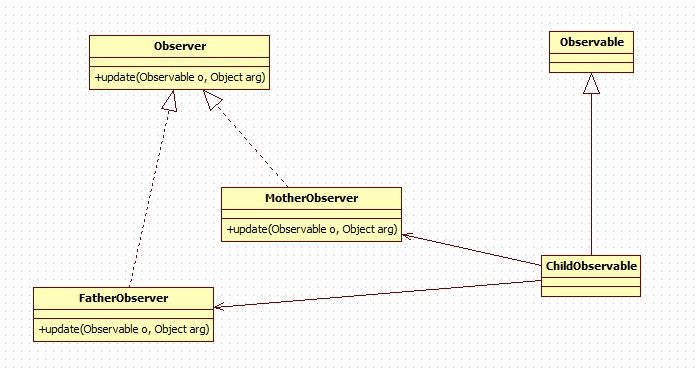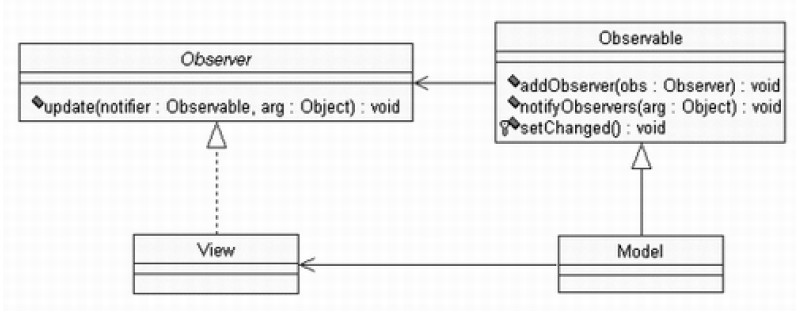设计模式-Observer(观察者模式)
Observer模式应该可以说是应用最多、影响最广的模式之一,因为Observer的一个实例Model/View/Control(MVC)结构在系统开发架构设计中有着很重要的地位和意义,MVC实现了业务逻辑和表示层的解耦。个人也认为Observer模式是软件开发过程中必须要掌握和使用的模式之一。在MFC中,Doc/View(文档视图结构)提供了实现MVC的框架结构(有一个从设计模式(Observer模式)的角度分析分析Doc/View的文章正在进一步的撰写当中,遗憾的是时间:))。在Java阵容中,Struts则提供和MFC中Doc/View结构类似的实现MVC的框架。另外Java语言本身就提供了Observer模式的实现接口,这将在讨论中给出。
当然,MVC只是Observer模式的一个实例。Observer模式要解决的问题为:建立一个一(Subject)对多(Observer)的依赖关系,并且做到当“一”变化的时候,依赖这个“一”的多也能够同步改变。最常见的一个例子就是:对同一组数据进行统计分析时候,我们希望能够提供多种形式的表示(例如以表格进行统计显示、柱状图统计显示、百分比统计显示等)。这些表示都依赖于同一组数据,我们当然需要当数据改变的时候,所有的统计的显示都能够同时改变。Observer模式就是解决了这一个问题。
模式结构图:

实现:
Observer: JDK中提供的
/*
* %W% %E%
*
* Copyright (c) 2006, Oracle and/or its affiliates. All rights reserved.
* ORACLE PROPRIETARY/CONFIDENTIAL. Use is subject to license terms.
*/
package java.util;
/**
* A class can implement the <code>Observer</code> interface when it
* wants to be informed of changes in observable objects.
*
* @author Chris Warth
* @version %I%, %G%
* @see java.util.Observable
* @since JDK1.0
*/
public interface Observer {
/**
* This method is called whenever the observed object is changed. An
* application calls an <tt>Observable</tt> object's
* <code>notifyObservers</code> method to have all the object's
* observers notified of the change.
*
* @param o the observable object.
* @param arg an argument passed to the <code>notifyObservers</code>
* method.
*/
void update(Observable o, Object arg);
}
FatherObserver:
package com.designpatten.observer;
import java.util.Observable;
import java.util.Observer;
public class FatherObserver implements Observer {
@Override
public void update(Observable o, Object arg) {
ChildObservable to = (ChildObservable)o ;
to.sick() ;
System.out.println("FatherObserver.update()=====" + arg);
}
}
MotherObserver:
package com.designpatten.observer;
import java.util.Observable;
import java.util.Observer;
public class MotherObserver implements Observer {
@Override
public void update(Observable o, Object arg) {
ChildObservable to = (ChildObservable)o ;
to.sick() ;
System.out.println("MotherObserver.update()=====" + arg);
}
}
Observable: JDK中提供的
/*
* %W% %E%
*
* Copyright (c) 2006, Oracle and/or its affiliates. All rights reserved.
* ORACLE PROPRIETARY/CONFIDENTIAL. Use is subject to license terms.
*/
package java.util;
/**
* This class represents an observable object, or "data"
* in the model-view paradigm. It can be subclassed to represent an
* object that the application wants to have observed.
* <p>
* An observable object can have one or more observers. An observer
* may be any object that implements interface <tt>Observer</tt>. After an
* observable instance changes, an application calling the
* <code>Observable</code>'s <code>notifyObservers</code> method
* causes all of its observers to be notified of the change by a call
* to their <code>update</code> method.
* <p>
* The order in which notifications will be delivered is unspecified.
* The default implementation provided in the Observable class will
* notify Observers in the order in which they registered interest, but
* subclasses may change this order, use no guaranteed order, deliver
* notifications on separate threads, or may guarantee that their
* subclass follows this order, as they choose.
* <p>
* Note that this notification mechanism is has nothing to do with threads
* and is completely separate from the <tt>wait</tt> and <tt>notify</tt>
* mechanism of class <tt>Object</tt>.
* <p>
* When an observable object is newly created, its set of observers is
* empty. Two observers are considered the same if and only if the
* <tt>equals</tt> method returns true for them.
*
* @author Chris Warth
* @version %I%, %G%
* @see java.util.Observable#notifyObservers()
* @see java.util.Observable#notifyObservers(java.lang.Object)
* @see java.util.Observer
* @see java.util.Observer#update(java.util.Observable, java.lang.Object)
* @since JDK1.0
*/
public class Observable {
private boolean changed = false;
private Vector obs;
/** Construct an Observable with zero Observers. */
public Observable() {
obs = new Vector();
}
/**
* Adds an observer to the set of observers for this object, provided
* that it is not the same as some observer already in the set.
* The order in which notifications will be delivered to multiple
* observers is not specified. See the class comment.
*
* @param o an observer to be added.
* @throws NullPointerException if the parameter o is null.
*/
public synchronized void addObserver(Observer o) {
if (o == null)
throw new NullPointerException();
if (!obs.contains(o)) {
obs.addElement(o);
}
}
/**
* Deletes an observer from the set of observers of this object.
* Passing <CODE>null</CODE> to this method will have no effect.
* @param o the observer to be deleted.
*/
public synchronized void deleteObserver(Observer o) {
obs.removeElement(o);
}
/**
* If this object has changed, as indicated by the
* <code>hasChanged</code> method, then notify all of its observers
* and then call the <code>clearChanged</code> method to
* indicate that this object has no longer changed.
* <p>
* Each observer has its <code>update</code> method called with two
* arguments: this observable object and <code>null</code>. In other
* words, this method is equivalent to:
* <blockquote><tt>
* notifyObservers(null)</tt></blockquote>
*
* @see java.util.Observable#clearChanged()
* @see java.util.Observable#hasChanged()
* @see java.util.Observer#update(java.util.Observable, java.lang.Object)
*/
public void notifyObservers() {
notifyObservers(null);
}
/**
* If this object has changed, as indicated by the
* <code>hasChanged</code> method, then notify all of its observers
* and then call the <code>clearChanged</code> method to indicate
* that this object has no longer changed.
* <p>
* Each observer has its <code>update</code> method called with two
* arguments: this observable object and the <code>arg</code> argument.
*
* @param arg any object.
* @see java.util.Observable#clearChanged()
* @see java.util.Observable#hasChanged()
* @see java.util.Observer#update(java.util.Observable, java.lang.Object)
*/
public void notifyObservers(Object arg) {
/*
* a temporary array buffer, used as a snapshot of the state of
* current Observers.
*/
Object[] arrLocal;
synchronized (this) {
/* We don't want the Observer doing callbacks into
* arbitrary code while holding its own Monitor.
* The code where we extract each Observable from
* the Vector and store the state of the Observer
* needs synchronization, but notifying observers
* does not (should not). The worst result of any
* potential race-condition here is that:
* 1) a newly-added Observer will miss a
* notification in progress
* 2) a recently unregistered Observer will be
* wrongly notified when it doesn't care
*/
if (!changed)
return;
arrLocal = obs.toArray();
clearChanged();
}
for (int i = arrLocal.length-1; i>=0; i--)
((Observer)arrLocal[i]).update(this, arg);
}
/**
* Clears the observer list so that this object no longer has any observers.
*/
public synchronized void deleteObservers() {
obs.removeAllElements();
}
/**
* Marks this <tt>Observable</tt> object as having been changed; the
* <tt>hasChanged</tt> method will now return <tt>true</tt>.
*/
protected synchronized void setChanged() {
changed = true;
}
/**
* Indicates that this object has no longer changed, or that it has
* already notified all of its observers of its most recent change,
* so that the <tt>hasChanged</tt> method will now return <tt>false</tt>.
* This method is called automatically by the
* <code>notifyObservers</code> methods.
*
* @see java.util.Observable#notifyObservers()
* @see java.util.Observable#notifyObservers(java.lang.Object)
*/
protected synchronized void clearChanged() {
changed = false;
}
/**
* Tests if this object has changed.
*
* @return <code>true</code> if and only if the <code>setChanged</code>
* method has been called more recently than the
* <code>clearChanged</code> method on this object;
* <code>false</code> otherwise.
* @see java.util.Observable#clearChanged()
* @see java.util.Observable#setChanged()
*/
public synchronized boolean hasChanged() {
return changed;
}
/**
* Returns the number of observers of this <tt>Observable</tt> object.
*
* @return the number of observers of this object.
*/
public synchronized int countObservers() {
return obs.size();
}
}
ChildObservable:
package com.designpatten.observer;
import java.util.Observable;
public class ChildObservable extends Observable {
public void notifyObservers(String arg){
super.notifyObservers(arg) ;
}
public void sick(){
System.out.println(this.getClass().getName() + "------> sick()");
}
public void changeT(){
super.setChanged() ;
}
}
ObserverMain:
package com.designpatten.observer;
public class ObserverMain {
public static void main(String[] args) {
ChildObservable observable = new ChildObservable() ;
FatherObserver father = new FatherObserver() ;
MotherObserver mother = new MotherObserver() ;
observable.addObserver(father) ;
observable.addObserver(mother) ;
observable.changeT() ;
if(observable.hasChanged()){
observable.notifyObservers("sick...") ;
}
}
}
讨论:
Observer是影响极为深远的模式之一,也是在大型系统开发过程中要用到的模式之一。除了MFC、Struts提供了MVC的实现框架,在Java语言中还提供了专门的接口实现Observer模式:通过专门的类Observable及Observer接口来实现MVC编程模式,其UML图可以表示为:

这里的Observer就是观察者,Observable则充当目标Subject的角色。
Observer模式也称为发布-订阅(publish-subscribe),目标就是通知的发布者,观察者则是通知的订阅者(接受通知)。
参考:C++设计模式 一书